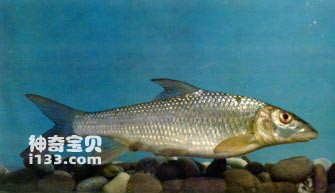Tor (Folifer) brevifilis belongs to the order Cypriniformes, family Cyprinidae, subfamily Tor (Folifer) brevifilis, genus Tor (Folifer) brevifilis, and subgenus Tor (Folifer) brevifilis. Commonly known as: Hasi, heavy mouth, Laju.
The body is slender, the sides are flat, the tail stalk is thin, and the abdomen is round. The head is long, the tip of the snout is pointed, protruding forward, with small white bead-like horny protrusions on the surface, and a deep crack and notch on the front edge of the preorbital bone. The mouth is large, lower-positioned, and horseshoe-shaped. The premaxillary bone can expand and contract freely, and the snout covers the upper jaw. The upper and lower lips are thick and slightly rolled upward. The upper lip has grooves and is divided into a middle lobe and lateral lobes. The lower lip is divided into 3 lobes. There is a long and narrow middle lobe in the center, which reaches backward almost to the vertical line of the corner of the mouth. There are 2 pairs of barbels, the kissing barbels are small and not obvious, and the jaw barbels are slightly longer, about half the length of the eye diameter. The scales are medium large, the chest scales are small, and the lateral line scales are 45-46. The dorsal fin has thick spines, the trailing edge is serrated, and the outer edge of the fin is concave. The back of the body is blue-gray or blue-black, the abdomen is gray-white, and there are crescent-shaped black spots at the base of most of the scales on the sides of the body. The dorsal fin and tail fin are dark, and the other fins are gray. There is a vertical black stripe on the side of the body of the juvenile fish, which is especially obvious in the second half.

The valve fish is a middle-lower fish that lives in clear flowing water. It has a streamlined body shape, a pointed head, and strong fins. It is one of the fish that is good at swimming. It often travels between rocks at the bottom of the water, using its trumpet-shaped retractable mouth to suck bottom molluscs, aquatic insects and their larvae at the bottom of the river and on the stone surface. Feeds on plant debris and filamentous algae. Generally, fish reach sexual maturity at the age of 3 winter, and the spawning period is estimated to be between June and July. Mature broodstock are required to reproduce under rapid current conditions.
The fish is widely distributed in the main stream and tributaries of the upper reaches of the Yangtze River, the Yuanjiang River, the Qingjiang River, the Pearl River, the Minjiang River, the Lancang River, the Yuanjiang River and Hainan Island. This fish is especially found in the upper reaches of the Yangtze River. Common edible fish. The growth rate is average, the first winter-old fish is 19-19.5 cm long; the second-winter-old fish is 27.6 cm long; the third-winter-old fish is 33.8-34.6 cm long; the fourth-winter-old fish is 36 cm long. Common individuals weigh 0.5-1 kg, and the largest ones can grow to more than 3 kg. Methods of domesticating and breeding in reservoirs are currently being explored.
animal tags:
We created this article in conjunction with AI technology, then made sure it was fact-checked and edited by a Animals Top editor.